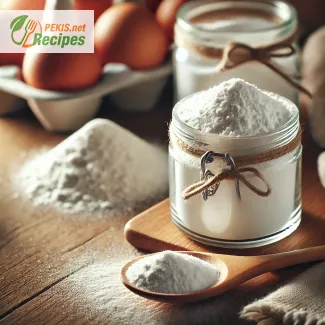
The Ultimate Guide to Cream of Tartar: Properties, Uses, and Benefits
What is Cream of Tartar?
Cream of tartar, scientifically known as potassium bitartrate, is a fine, white powder derived from tartaric acid. It is a byproduct of the wine-making process, formed as crystals on the inside of wine barrels during fermentation. This ingredient is well-known in the culinary world for its stabilizing, leavening, and anti-caking properties.
Characteristics of Cream of Tartar
- Chemical Composition: Potassium bitartrate (KC₄H₅O₆)
- Appearance: White, odorless powder
- Taste: Mildly acidic
- Solubility: Soluble in water
- pH Level: Acidic (pH around 3.5-5)
- Shelf Life: Indefinite if stored in a dry and cool place
Can You Substitute Cream of Tartar?
If you don’t have cream of tartar on hand, several substitutes can mimic its effects:
- Lemon juice or vinegar: Use 1 teaspoon of lemon juice or vinegar for every ½ teaspoon of cream of tartar.
- Baking powder: Since baking powder contains both baking soda and cream of tartar, you can substitute 1½ teaspoons of baking powder for 1 teaspoon of cream of tartar.
- Buttermilk or yogurt: These acidic dairy products can be used in recipes requiring acidity.
Why is Cream of Tartar Used in Cooking?
This versatile ingredient plays multiple roles in both baking and cooking:
- Stabilizes egg whites – It prevents proteins from denaturing, ensuring fluffy meringues and soufflés.
- Prevents sugar crystallization – Helps create smooth icings, frostings, and syrups.
- Leavening agent – Reacts with baking soda to produce carbon dioxide, making baked goods light and airy.
- Prevents discoloration of vegetables – Keeps greens vibrant while boiling.
- Maintains whipped cream texture – Prevents over-whipping and curdling.
Secret Effects of Cream of Tartar in Baking
Cream of tartar enhances the structure, stability, and texture of baked goods. Some of the key effects include:
- Fluffier baked goods: By stabilizing egg whites and creating a fine foam structure, it ensures a light texture.
- Crispier cookies and macarons: It helps control moisture and sugar crystallization, leading to a crispier exterior.
- Better texture in candy making: Prevents sugar from re-crystallizing, ensuring smooth caramels and syrups.
Why is Cream of Tartar So Useful in Recipes?
Many recipes call for cream of tartar due to its natural acidity and stabilizing abilities. Some popular uses include:
- Snickerdoodle cookies: Gives them their signature tangy taste and chewy texture.
- Meringues and marshmallows: Ensures stable and glossy peaks.
- Pancakes and waffles: Helps achieve a soft, airy texture.
- Angel food cake: Prevents egg whites from deflating, resulting in a fluffy cake.
How Does Cream of Tartar Work?
Chemically, cream of tartar acts as an acidic stabilizer in baking. When mixed with baking soda, it produces carbon dioxide gas, which creates tiny air pockets in doughs and batters, resulting in a light and airy texture. Additionally, its anti-crystallization properties prevent sugar from forming gritty textures in frostings and syrups.
Health Benefits of Cream of Tartar
Beyond baking, cream of tartar has several health benefits:
- Alkalizing agent: Helps balance the body’s pH levels.
- Natural detoxifier: Can assist in flushing out toxins.
- Aids in kidney function: Potassium content supports kidney health.
- May help relieve arthritis pain: Some claim it reduces inflammation.
- Prevents UTIs: Acidifies urine, discouraging bacterial growth.
Growing and Producing Cream of Tartar
Although cream of tartar is a byproduct of wine-making, its formation depends on specific growing conditions:
- Climate: Grape vines thrive in Mediterranean climates.
- Soil Requirements: Well-drained, slightly acidic soils.
- Wine Fermentation Process: Tartaric acid naturally forms as a crystalline deposit in wine barrels.
- Harvesting and Refinement: Crystals are purified and ground into a fine powder.
Cream of tartar is a powerful yet often overlooked ingredient that enhances baking, stabilizes whipped mixtures, and provides several health benefits. Whether you’re using it in cookies, meringues, or syrups, its versatility makes it an essential addition to any kitchen. Ensure you store it properly to maintain its potency, and experiment with it in different recipes to make the most of its unique properties.